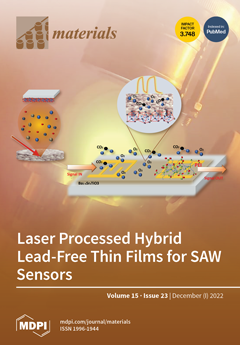Nanobiotechnology influences many different areas, including the medical, food, energy, clothing, and cosmetics industries. Considering the wide usage of nanomaterials, it is necessary to investigate the toxicity potentials of specific nanosized molecules. Boron-containing nanoparticles (NPs) are attracting much interest from scientists due to
[...] Read more.
Nanobiotechnology influences many different areas, including the medical, food, energy, clothing, and cosmetics industries. Considering the wide usage of nanomaterials, it is necessary to investigate the toxicity potentials of specific nanosized molecules. Boron-containing nanoparticles (NPs) are attracting much interest from scientists due to their unique physicochemical properties. However, there is limited information concerning the toxicity of boron-containing NPs, including cobalt boride (Co
2B) NPs. Therefore, in this study, Co
2B NPs were characterized using X-ray crystallography (XRD), transmission electron microscope (TEM), scanning electron microscope (SEM), and energy-dispersive X-ray spectroscopy (EDX) techniques. Then, we performed 3-(4,5-dimethyl-thiazol-2-yl) 2,5-diphenyltetrazolium bromide (MTT), lactate dehydrogenase (LDH) release, and neutral red (NR) assays for assessing cell viability against Co
2B NP exposure on cultured human pulmonary alveolar epithelial cells (HPAEpiC). In addition, whole-genome microarray analysis was carried out to reveal the global gene expression differentiation of HPAEpiC cells after Co
2B NP application. The cell viability tests unveiled an IC50 value for Co
2B NPs of 310.353 mg/L. The results of our microarray analysis displayed 719 gene expression differentiations (FC ≥ 2) among the analyzed 40,000 genes. The performed visualization and integrated discovery (DAVID) analysis revealed that there were interactions between various gene pathways and administration of the NPs. Based on gene ontology biological processes analysis, we found that the P53 signaling pathway, cell cycle, and cancer-affecting genes were mostly affected by the Co
2B NPs. In conclusion, we suggested that Co
2B NPs would be a safe and effective nanomolecule for industrial applications, particularly for medical purposes.
Full article






